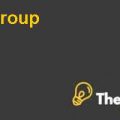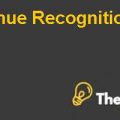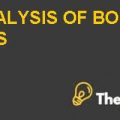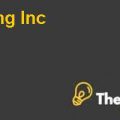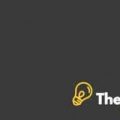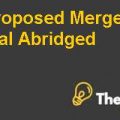WACC:
The WACC for Astral is 9.5% (Appendix 1).The WACC is derived from the individual weightings and individual returns of debt and equity. The cost of equity is derived through capital asset pricing model (CAPM) that is widely used and acceptable method to calculate the cost of capital. Under the CAPM model the risk free return is 6.2% (30 years US treasury bonds), and the market average return is 11% and the beta equity is 1.72 (Appendix 1). The beta equity is derived from beta asset; the beta asset is the industry related risk that is systematic risk. The systematic risk is unavoidable risk; the company cannot ignore this risk as it has to bear the risk at any cost. The beta asset is 1.003; this is derived from the beta asset of the companies in the industry that are provided in the exhibit 5. The beta equity consists of systematic risk and the company’s own gearing risks that is debt financing. The cost of equity for the company is 14.4% (Appendix 1).
The company finances 54% of the debts and only 46% equity financing, the company is highly gearing, therefore the cost of debt is 9%, the cost of debt is 9% of the debt instruments having B rating. It shows that the company is not very attractive due to high gearing ratio. However, the cost of debt is 5.45% less than the cost of equity, but the higher debt increases the cost of equity and cost of debt also comes with the tax saving of 40% on the interest expense. The net of tax cost of debt is 5.4%, i.e. 11% lower than that cost of equity, due to the high gearing the weighted average cost of capital is 9.5% (Appendix 1).
Cash flow forecast for five years:
The five year cash flow forecast is based upon the common assumptions of free cash flows; the free cash flows are the amount remaining in debt and equity holders. To get the free cash flows, the company’s profit before interest and tax (PBIT) must be derived. It is estimated that the company’s revenues will grow by 15% in the next two years and then 5% for the period of 3 next years. The revenues have increased from $457 million to $609 million during the 5 years of the period. The cost of goods sold is considered to be 60% of the revenues and selling, general and administration expense is 30% of the revenues. The profit before interest and tax is $4.6 million in 1994 and it is 6.1 million in 1998. The free cash flows are derived through adjusting depreciation, capital expenditure and tax expense. The depreciation is not the cash expense, therefore it must be added back to the profits and capital expenditure is the real cash expense to maintain the current production capacity and future consequences to expand the business and production capacity. The free cash flows for the year 1994 are $7.061 million and it is 9.4 million for the year 1998 (Appendix 2).
Enterprise value and value of the firm:
The enterprise value through free cash flows is $163.3 million. The value is derived through the estimation that the required return of the company is 9.5%, i.e. WACC and the growth of 5% in revenues will last for the period of perpetuity. It is also derived that the growth in free cash flows is also 5% from the year 1996 to 1998. The terminal value is derived at the year-end 1998 considers the growth rate of 5% is constant for perpetuity period and the discount rate is 9.5%. It is considered that the discount rate remains same for the period of perpetuity. The value of shareholder’s equity is $114.2 million. The value is derived from deducting the total liabilities (current and non-current) from the total value of the firm (Appendix 2).
Sensitivity analysis:
The key risk factor in the company’s valuation is the first risk is that the growth of 5% is assumed for the period of perpetuity that does not seem to be a valid assumption. The second assumption is that the WACC remains constant over the perpetuity that is also not a valid assumption because any of the variables used to change the value. The risks are acceptable because these assumptions are valid to derive the value and it is assumed that the changes in WACC are also incorporated in the future years and the value is also risk adjusted for such changes........................
This is just a sample partial case solution. Please place the order on the website to order your own originally done case solution.

